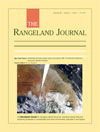
The Rangeland Journal
Volume 35 Number 2 2013
Celebrating Diversity: People, Place and Purpose. ARS 17th Biennial Conference, Kununurra, Western Australia
RJ12077Global trends in population, energy use and climate: implications for policy development, rangeland management and rangeland users
This paper examines how global trends in human population, energy use, water use and climate change will impact upon rangelands and rangeland users. Implications from policy, conservation and producer standpoints are provided. Various sources of information are identified for readers seeking more detail than is provided by the paper.
Big dust storms have a large impact on the soil resource and people. This is the first peer-reviewed published costing of a single dust storm for Australia. The total costs of the Red Dawn dust storm of 23 September 2009 to the economy of New South Wales, Australia were estimated to be A$299 million. Investing in better land management practices in rural areas significantly benefits people in large urban areas.
RJ12085 Abstract | RJ12085 Full Text | RJ12085PDF (1.1 MB) Open Access Article
RJ12083Balancing trade-offs between biodiversity and production in the re-design of rangeland landscapes
A model prototype is developed to understand the relationship between biological diversity and agricultural production. With further validation, this model could be used to re-design land use on a pastoral property to meet both production and conservation needs. The process for model development is outlined and its application as a planning tool for land management is highlighted.
RJ12078Revegetation with Australian native grasses – a reassessment of the importance of using local provenances
The recent geological history of the Australian continent has not resulted in the widespread destruction of the grass biota followed by rapid recolonisation as has occurred with the temperate grasses of North America and Europe. This different history is reflected in the reproductive mechanisms of the two groups of grasses. Obligatory cross-pollination is common in the northern hemisphere temperate grasses but is rare in the Australian. Different and often complex predominantly inbreeding systems are common in the Australian grass flora. The result is that the recommended use of local provenances for revegetation is mostly inappropriate with respect to native Australian grasses.
RJ13012Relic bilby (Macrotis lagotis) refuge burrows: assessment of potential contribution to a rangeland restoration program
Relic bilby burrows were shown to modify microclimate and soil chemical properties compared with intact soil in the arid zone of Western Australia. The potential of these modifications to contribute to rangeland restoration is discussed.
RJ12090A framework for optimising capital investment and operations in livestock logistics
The Australian livestock industry is characterised by long-distance supply chains that are highly vulnerable to market and climate shocks. Investment in supporting infrastructure can reduce such vulnerability and a whole of industry logistics tool is needed to evaluate and optimise suitable options. Here a set of tools is highlighted, which was not previously available to the beef industry, which can address a wide range of infrastructure options (e.g. roads, bridges, feedlots, holding yards, abattoirs) and policies (e.g. driver fatigue) to minimise transport costs and allow scenario testing for alternate infrastructure developments and market options.
RJ12084Scaling results up from a plot and paddock scale to a property – a case study from a long-term grazing experiment in northern Australia
The determination of appropriate stocking rates is an important aspect of grazing management in northern Australia. The results from a long-term grazing experiment at Wambiana, Queensland are used to demonstrate how data from a grazing experiment can be scaled up to a property level to examine economic performance. The results suggest that a conservative fixed stocking rate for a breeding-finishing cattle enterprise is similar to, if not superior to, stocking strategies that involve changing cattle numbers each year.
RJ13020Alternative strategies for management of feral goats: implications for natural resource management policies in New South Wales rangelands
This paper presents an economic assessment of a range of alternative strategies for the management of feral goats and discusses their implications for natural resource management policy. It concludes that public funds would be better used to support training in grazing management and provide incentives for achieving measurable natural resource outcomes than to support establishment of infrastructure for harvesting feral goats on private properties.
RJ12102Understanding ecosystem dynamics in South Australia’s arid lands: a framework to assist biodiversity conservation
This paper describes a conceptual framework that is intended to allow the identification of biodiversity conservation priorities at a landscape scale. The framework has been developed to meet the needs of conservation planning in South Australia’s arid rangelands, and its application is illustrated in the context of Witjira National Park in the north of the State.
RJ12080A more effective means of delivering conservation management: a ‘New Integrated Conservation’ model for Australian rangelands
The paper highlights the inadequacies of current policy arrangements for achievement of conservation objectives in the Australian rangelands and proposes an alternative framework aimed at broadening the sources of funding available for conservation and establishing governance arrangements more appropriate to the socio-ecological characteristics of the region.
RJ13032Using economic, social and ecological spatial patterns to guide policy development in the Pilbara and Southern Rangelands of Western Australia
Past governance and support mechanisms have been largely unsuccessful in resolving the ongoing economic, social and ecological challenges in the Pilbara and Southern Rangelands of Western Australia. This paper describes an approach for understanding the combined economic, social and ecological patterns in rangelands landscapes that could provide a basis for policy and special purpose initiative development.



